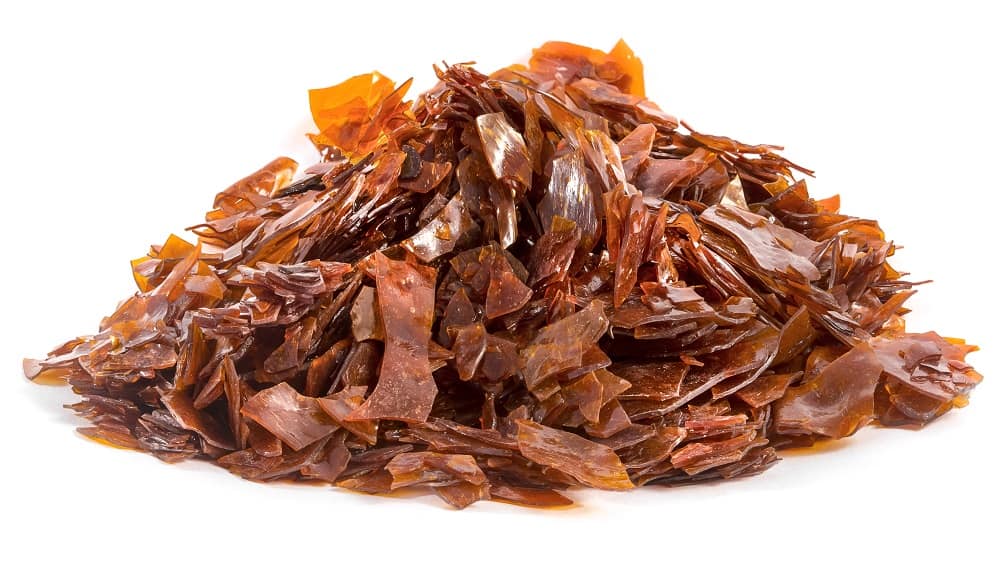Shellac is a resinous product that is typically used as a brush-on colorant, food glaze, and wood finish. Due to its unique chemical properties, shellac is an effective natural primer, sanding sealant, tannin blocker, odor blocker, and high-gloss varnish.
Unfortunately, shellac is not vegan since it is a product directly obtained from an animal source. Specifically, shellac is a resin obtained from the secretions of the female lac bug (Kerria lacca).
Table of Contents
What is Shellac?
Shellac is a resin product that is typically found in food, cosmetics, pharmaceuticals, and polishes (1). From commercial production, shellac typically comes in flakes and shards. However, the material can easily be dissolved in a solvent such as ethanol to make liquid shellac that can then be used to brush on other products.

Structurally, shellac is composed of different polyesters of mainly aleuritic acid, shellolic acid, and a small amount of free aliphatic acids. However, the composition can vary depending on the insects involved and the host tree from which the lac was obtained.
Shellac Production
Shellac is specifically the refined form of lac, the resinous secretion of the female lac insect that has been found to parasitically inhabit certain trees in India, Burma, and Thailand. While Shellac is primarily obtained from India and Thailand, the insect can be found in other Asian countries to a minor extent as well.
Shellac production starts with the lac larvae. As soon as the larvae of the lac insect emerge from the eggs, they swarm around the branches of the host tree. It is estimated that an infected tree can have up to 100-150 larvae on each twig. After about 2-3 days of swarming the tree and finding a suitable spot, a larva would then insert its proboscis into the tree, reaching the phloem to access the sap juices.
Once the larvae get situated and have access to the host tree’s sap, the larvae then begin to secrete lac around their bodies to produce cells where they will spend much of their lives. Male lac insects can move in and out of their cells, but female lac insects remain in the cells throughout their entire lives. The lac insects have about eight weeks to mature after hatching, after which sexually mature lac insects would mate within a few days.
Once female lac insects are fertilized, they produce large quantities of lac to house the eggs. Female lac insects are estimated to lay about 200-500 eggs. The eggs are sheltered in the lac secretions until they hatch as well.
In the commercial production of shellac, the lac resin is harvested from the host trees before the eggs hatch. However, farmers would take a few twigs that contain the eggs and tie these to other trees to provide sources of lac that will produce succeeding generations.
Modern production methods of shellac still rely on traditional methods used in the past. The lac resin that is bound to the twigs and branches is scraped off the wood. At this point, the product is called sticklac and is composed of lac resin, dead lac insects, and wooden debris. The sticklac is repeatedly cleaned by mechanical and manual methods to remove impurities and debris. Once the debris is removed, it is called seedlac. However, seedlac is still not shellac and still contains around 3-8% impurities.
Lastly, seedlac is converted to shellac by one of two methods: either by heating or by solvent. In the heating process, the seedlac is melted down and filtered through a fine cloth to remove the remaining wooden debris. In the solvent method, the seedlac is dissolved in an appropriate solvent such as ethyl alcohol and is also filtered through a fine cloth to remove the remaining debris.
Is Shellac Vegan?
Although shellac is a popular natural resin, it cannot be considered vegan since it is directly obtained from an animal source – the lac insects. The production of shellac is directly tied with the death of thousands of these insects. It is estimated that a kilogram of shellac can mean the death of around up to 300 thousand lac insects (2).
One problem with shellac is that it might be more ubiquitous than one previously assumes. As a glazing ingredient, it can be found in unsuspecting places. While it is listed as an ingredient in food products like candies, chocolates, and more, shellac can actually be found in fruits. It has long been known that supermarkets and stores use shellac to coat fruits such as apples, citrus, and pears to give the fruits a shiny coat as a way to impress buyers (3).
People might also be unknowingly consuming shellac by taking medicine. Shellac is a common tablet-coating agent. Due to the acidic property of shellac, it serves as an effective enteric coating to let medication resist dissolution in the stomach acid. It is also a common ingredient in cosmetics and can be found in various products such as mascara, hair spray, nail polish, and eyeliner (4).
Food that Contains Shellac
One of the most common food items that would contain shellac could be candies, chocolates, and pastries because these food items can be coated with an ingredient called “confectioner’s glaze.” It is a common ingredient used by confectioners and chocolatiers to give their products a shiny and appealing coat. However, shellac is among the primary ingredients of confectioner’s glaze which is why it is important to look out for these ingredients.
Even if a pastry is thought to be made with vegan ingredients, the addition of sprinkles can already be a cause of concern due to the confectioner’s glaze.
Additionally, fruits in supermarket stands can be coated with fruit wax that contains shellac as a way to make the fruits look more appealing. Fortunately, there are various methods to remove the shellac to ensure the consumption of fruits in a vegan way. The fruit wax can be removed by rinsing the fruits in water. Gentle scrubbing is recommended for thicker wax coats.
References
1. https://www.researchgate.net/
2. https://www.curiouschloride.com/




